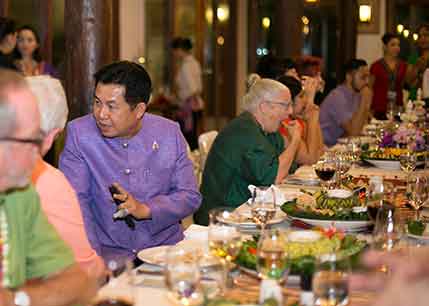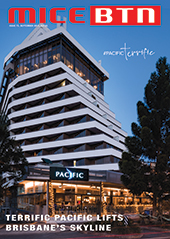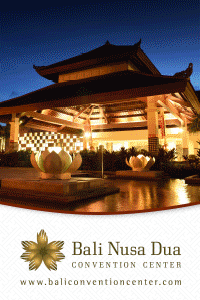Bangkok and beyond MICE strategy working well for Thailand
- MICE News
- Friday, 05 August 2016
 While Bangkok will always be Thailand’s premier MICE destination the country has been investing heavily over recent years in developing alternatives including both major visitor traffic areas such as Krabi, Pattaya and Phuket and other places as yet with only limited international profile such as Khao Yai (Nakhon Ratchasima or Khorat) and Khon Kaen (Isan).
While Bangkok will always be Thailand’s premier MICE destination the country has been investing heavily over recent years in developing alternatives including both major visitor traffic areas such as Krabi, Pattaya and Phuket and other places as yet with only limited international profile such as Khao Yai (Nakhon Ratchasima or Khorat) and Khon Kaen (Isan).
Pictured above: Chiang Rai deputy governor Prachon Pratsakul talks with MICE-BTN senior journalist Kelvin King in the banquet room at Mae Fah Luang Art and Cultural Park. Both are wearing traditional Lanna apparel, readily available to all MICE visitors.
This concept of marketing MICE cities beyond Bangkok is an initiative of the Thai Convention and Exhibition Bureau www.tceb.or.th supported by a number of partners including Tourism Authority of Thailand and Thai Airways International as well as other government agencies such as the foreign affairs department which has involved its overseas embassies in propagating the message.
As reported over the past few years private and government (provincial and city level as well as national) investment has driven progress in MICE facilities, even in areas not yet considered as being on the regional C&I frontline.
TCEB president Nopparat Maythaveekulchai says the domestic and international marketing of MICE cities beyond Bangkok is building momentum. It’s starting to draw good business, he points out but needs constant highlighting to achieve its goals.
With this in mind, TCEB and partners are currently highlighting the northern city of Chiang Rai as another alternative which for all its appeal is only now coming into its own as a significant C&I venue.
Chiang Rai enjoys the benefit of being compact, relatively small, relaxed and imbued with a unique culture: Lanna which extends to distinctive architecture, cuisine and even apparel which sets it very positively for MICE purposes.
It is part of the Golden Triangle, once imbued with a shady reputation for drug production and distribution. That’s largely in the past now, thanks partly to a royal initiative to identify and develop alternative revenue sources for hill tribes. Crops developed under the royal patronage include coffee, bananas, coconuts and pineapples.
The Golden Triangle brings together three countries. C&I visitors can enjoy lunch at the Anantara Golden Triangle Elephant Camp & Resort www.goldentriangle.anantara.com – a property which offers two meeting rooms as well as an al fresco terrace handling up to 150 pax – looking out over the Mekong and smaller rivers which form the border with nearby Myanmar (Shan State) and the Lao PDR (Bokeo Province).
The Anantara’s impressive activities schedule not only offers a range of elephant activities as its name signals but also a cross-border tour of the Golden Triangle countries. Visitors must have the appropriate border clearance.
Mae Fah Luang-Chiang Rai International Airport, one of the Airports of Thailand stable has only a single runway and no complementary taxiway but is very busy with domestic services (Thai Smile, Bangkok Airways, Nok Air Thai AirAsia, Thai Lion Air), from/to Bangkok-Suvarnabhumi, Bangkok-Don Mueang and a range of smaller centres.
International services are currently limited to a China Eastern link with Kunming but HK Express plans to start a Hong Kong service from late November.
Prachon Pratsakul, deputy governor of Chiang Rai Province and a committed supporter of MICE sector development in the region says that a taxiway is currently under consideration to allow more operational flexibility.
“Airports of Thailand is looking at attracting more flights, especially from ASEAN countries,” he told MICE-BTN. “We’re also working on more domestic flights, not just from Bangkok.
“These are likely to build up gradually.”
The provincial government was working closely with AOT, he said.
AOT was keen to spread some of Chiang Mai’s air service load to Chiang Rai, he explained, with Chinese links a priority.
The deputy governor sees increasing regional cooperation between Thailand, Myanmar and Lao PDR as a benefit to MICE, not only in attracting more C&I traffic from within the region but also delivering a unique experience to business visitors.
Other event facilities in Chiang Rai include the magnificent Le Méridien Chiang Rai Resort www.lemeridienchiangrai.com, the unique Mae Fah Luang Art and Cultural Park www.maefahluang.org, Choui Fong Tea Plantation www.chouifongtea.com and Singha Park www.singhapark.com
- We’ll be looking further at Chiang Rai in our 2016 spring print edition of MICE-BTN.










